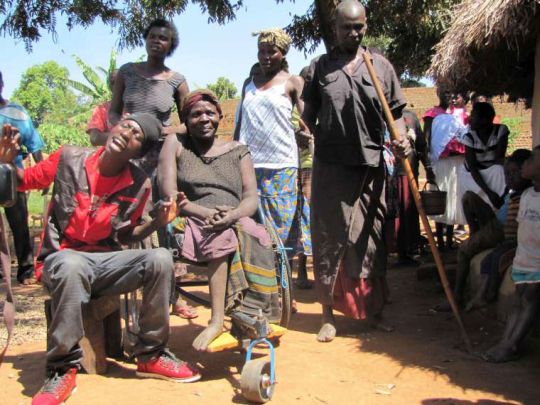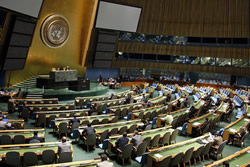UN refugee agency concludes work among displaced in northern Uganda
UN refugee agency concludes work among displaced in northern Uganda
 Lucky David Wilson (left) filming his music video with Achan Katherine in Unyama trading centre, a former IDP camp in northern Uganda
Lucky David Wilson (left) filming his music video with Achan Katherine in Unyama trading centre, a former IDP camp in northern Uganda
The United Nations refugee agency said today it has concluded relief work among nearly two million internally displaced persons (IDPs) in Uganda, the majority of whom have returned to their villages, after years in camps as an insurrection raged in the country’s north.
The UN High Commissioner for Refugees (UNHCR) closed its office in the northern Uganda town of Gulu last week, bringing to an end its support for those displaced by the warfare that pit Ugandan armed forces against the Lord’s Resistance Army (LRA) rebels, the agency’s spokesperson, William Spindler, told reporters in Geneva.
Hostilities died down in 2006, allowing most of the IDPs to return to their villages.
At the conflict’ peak in 2005, there were 1.84 million IDPs living in 251 camps across 11 districts of northern Uganda. Hostilities died down in 2006, allowing most of the IDPs to return to their villages.
The UNHCR office in Gulu had since 2006 focused on camp management and the protection of IDPs. The agency also helped 11,600 of the most vulnerable IDPs to either return home or to integrate into communities where lived. It also provided basic reintegration help, including water, building roads, schools, health centres, police posts and other infrastructure.
Some 30,000 displaced Ugandans are still living in four remaining camps, transit centres and in local communities.
Returnee assistance programmes have been integrated into the Government’s long-term development to ensure a smooth transition from relief to recovery. UNHCR also handed over its protection role to the Ugandan Human Rights Commission, which now handles issues related to IDPs’ land and human rights.
###
UNHCR closes chapter on Uganda’s internally displaced people
6 January 2012
This is a summary of what was said by UNHCR spokesperson William Spindler – to whom quoted text may be attributed – at the press briefing, on 6 January 2012, at the Palais des Nations in Geneva.
The UN refugee agency has ended its assistance to nearly 2 million internally displaced people (IDPs) in Uganda as the vast majority have returned home.
Last week, we closed the UNHCR office in Gulu, northern Uganda after five years of assisting and protecting people displaced by fighting between the Ugandan army and the rebel Lord’s Resistance Army. At the conflict’s peak in 2005, there were 1.84 million IDPs living in 251 camps across 11 districts of northern Uganda.
Since the warring parties signed an agreement to cease hostilities in 2006, almost all IDPs have returned to their villages on their own. UNHCR opened its Gulu office in 2006, focusing on camp management and the protection of IDPs. The agency has since helped 11,600 of the most vulnerable IDPs to either return home or to integrate where they are. This involves resolving land issues, building huts and latrines for needy individuals, providing a start-up kit and support safety net in the form of blankets, kitchen sets, livestock, seeds and tools.
For the wider returnee community, UNHCR has provided basic reintegration help, providing safe water, building roads, schools, health centres, police posts and other infrastructure.
Some 30,000 displaced Ugandans are still living in four remaining camps, as well as former camps, transit centres and in local communities. 247 IDP camps have been closed after making sure that the land was cleaned up and rehabilitated before being handed back to the original owners.
Further actions and interventions on behalf of the returned IDPs have now been integrated into the government’s long-term development and recovery programmes so as to ensure that the transition from humanitarian/relief to recovery/development efforts is as seamless as possible, and in order to maintain the sustainability of returns. UNHCR has also handed over its protection role to the Uganda Human Rights Commission, which now handles issues related to IDPs’ land and human rights.
###
About the Office of the United Nations High Commissioner for Refugees (UNHCR)

The Office of the United Nations High Commissioner for Refugees was established on December 14, 1950 by the United Nations General Assembly. The agency is mandated to lead and co-ordinate international action to protect refugees and resolve refugee problems worldwide. Its primary purpose is to safeguard the rights and well-being of refugees. It strives to ensure that everyone can exercise the right to seek asylum and find safe refuge in another State, with the option to return home voluntarily, integrate locally or to resettle in a third country. It also has a mandate to help stateless people.
In more than six decades, the agency has helped tens of millions of people restart their lives.
Today, a staff of some 7,685 people in more than 125 countries continues to help some 33.9 million persons.
###
> United Nations (UN).
 The United Nations was established on 24 October 1945 by 51 countries committed to preserving peace through international cooperation and collective security. Today, nearly every nation in the world belongs to the UN: membership totals 192 countries.
The United Nations was established on 24 October 1945 by 51 countries committed to preserving peace through international cooperation and collective security. Today, nearly every nation in the world belongs to the UN: membership totals 192 countries.
When States become Members of the United Nations, they agree to accept the obligations of the UN Charter, an international treaty that sets out basic principles of international relations. According to the Charter, the UN has four purposes:
- to maintain international peace and security;
- to develop friendly relations among nations;
- to cooperate in solving international problems and in promoting respect for human rights;
- and to be a centre for harmonizing the actions of nations.
###
* The above story is adapted from materials provided by United Nations (UN)
** More information at United Nations (UN)




















